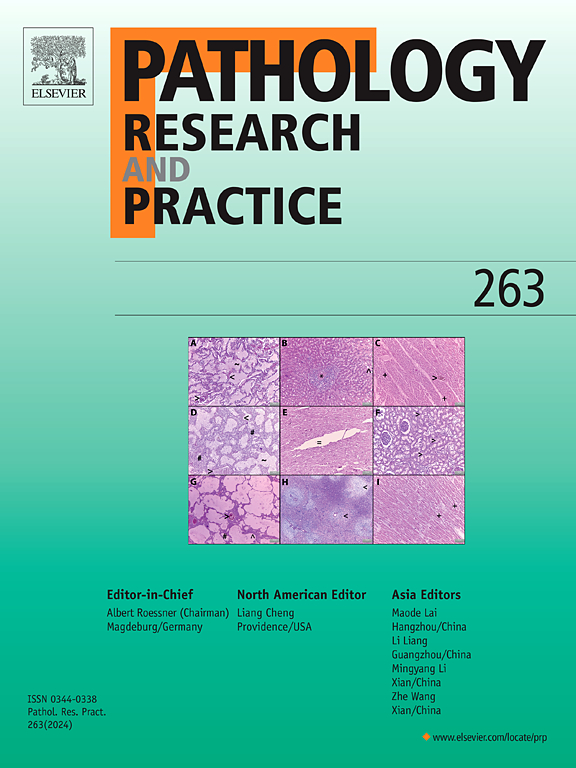Comprehensive clinicopathologic features in autoimmune atrophic gastritis: Insights from a European cohort of 57 patients
IF 3.2
4区 医学
Q2 PATHOLOGY
引用次数: 0
Abstract
Context
Autoimmune atrophic gastritis (AAG) is a frequently underdiagnosed disease due to its broad-spectrum clinical presentation. The diagnosis is based on histological confirmation of corpus-restricted metaplastic chronic atrophic gastritis.
Objective
To thoroughly describe the histological features of a European cohort of AAG patients.
Design
Clinical and pathological data of 57 out of 676 patients diagnosed with AAG were reviewed.
Results
Thirty-nine patients were female and eighteen were male. The mean age was 62 years. Antibodies were identified in 32/42 patients (76 %). Vitamin B12 levels were low (< 200 pg/mL) in 37/54 patients (69 %). Serum gastrin levels was elevated (> 115 pg/mL) in all cases tested. Associated autoimmune/inflammatory conditions were identified in 20/57 patients (35 %). Histologically, deep chronic inflammation was present in 46/57 (81 %) patients. Complete destruction of oxyntic glands was observed in 45/57 (79 %) patients. Pyloric metaplasia was present in 54/57 (95 %) patients, intestinal metaplasia in 51/57 (89 %) patients, and pancreatic metaplasia in 20/57 (35 %) patients. Among ECL cell proliferation, linear hyperplasia was present in all 57/57 patients, micronodular hyperplasia in 55/57 patients, and adenomatoid hyperplasia in 10/57 patients. ECL cell dysplasia was identified in 5/57 patients, and neuroendocrine microtumor in 4/57 patients.
Conclusions
The diagnosing of AAG remains challenging due to the greater variability in symptoms than previously recognized. It is important to consider chronic AAG, especially with other concurrent autoimmune conditions. The importance of accurate diagnosis and surveillance is based on the potential development of type 1 gastric neuroendocrine tumor and increased risk of gastric adenocarcinoma.
自身免疫性萎缩性胃炎的综合临床病理特征:从欧洲 57 例患者队列中获得的启示。
背景:自身免疫性萎缩性胃炎(AAG)是一种经常被漏诊的疾病,因其临床表现广泛。诊断的依据是组织学上对胃体局限性变性慢性萎缩性胃炎的确认:彻底描述欧洲 AAG 患者群的组织学特征:设计:对676名确诊为AAG患者中57名患者的临床和病理数据进行回顾:结果:39 名患者为女性,18 名患者为男性。平均年龄为 62 岁。32/42(76%)名患者体内发现了抗体。37/54 名患者(69%)的维生素 B12 水平较低(< 200 pg/mL)。所有受检病例的血清胃泌素水平均升高(> 115 pg/mL)。在 20/57 例患者(35%)中发现了相关的自身免疫/炎症情况。从组织学角度看,46/57 例患者(81%)存在深度慢性炎症。在 45/57 例(79%)患者中观察到了氧化腺的完全破坏。54/57(95%)例患者出现幽门化生,51/57(89%)例患者出现肠化生,20/57(35%)例患者出现胰腺化生。在 ECL 细胞增生中,57/57 例患者均出现了线状增生,55/57 例患者出现了微粒增生,10/57 例患者出现了腺瘤样增生。在5/57例患者中发现了ECL细胞发育不良,在4/57例患者中发现了神经内分泌微瘤:结论:AAG 的诊断仍然具有挑战性,因为其症状的变异性比以前认识到的更大。重要的是要考虑慢性 AAG,尤其是同时患有其他自身免疫性疾病的患者。准确诊断和监测的重要性在于可能发展为 1 型胃神经内分泌瘤和增加胃腺癌的风险。
本文章由计算机程序翻译,如有差异,请以英文原文为准。
求助全文
约1分钟内获得全文
求助全文
来源期刊
CiteScore
5.00
自引率
3.60%
发文量
405
审稿时长
24 days
期刊介绍:
Pathology, Research and Practice provides accessible coverage of the most recent developments across the entire field of pathology: Reviews focus on recent progress in pathology, while Comments look at interesting current problems and at hypotheses for future developments in pathology. Original Papers present novel findings on all aspects of general, anatomic and molecular pathology. Rapid Communications inform readers on preliminary findings that may be relevant for further studies and need to be communicated quickly. Teaching Cases look at new aspects or special diagnostic problems of diseases and at case reports relevant for the pathologist''s practice.

 求助内容:
求助内容: 应助结果提醒方式:
应助结果提醒方式:


